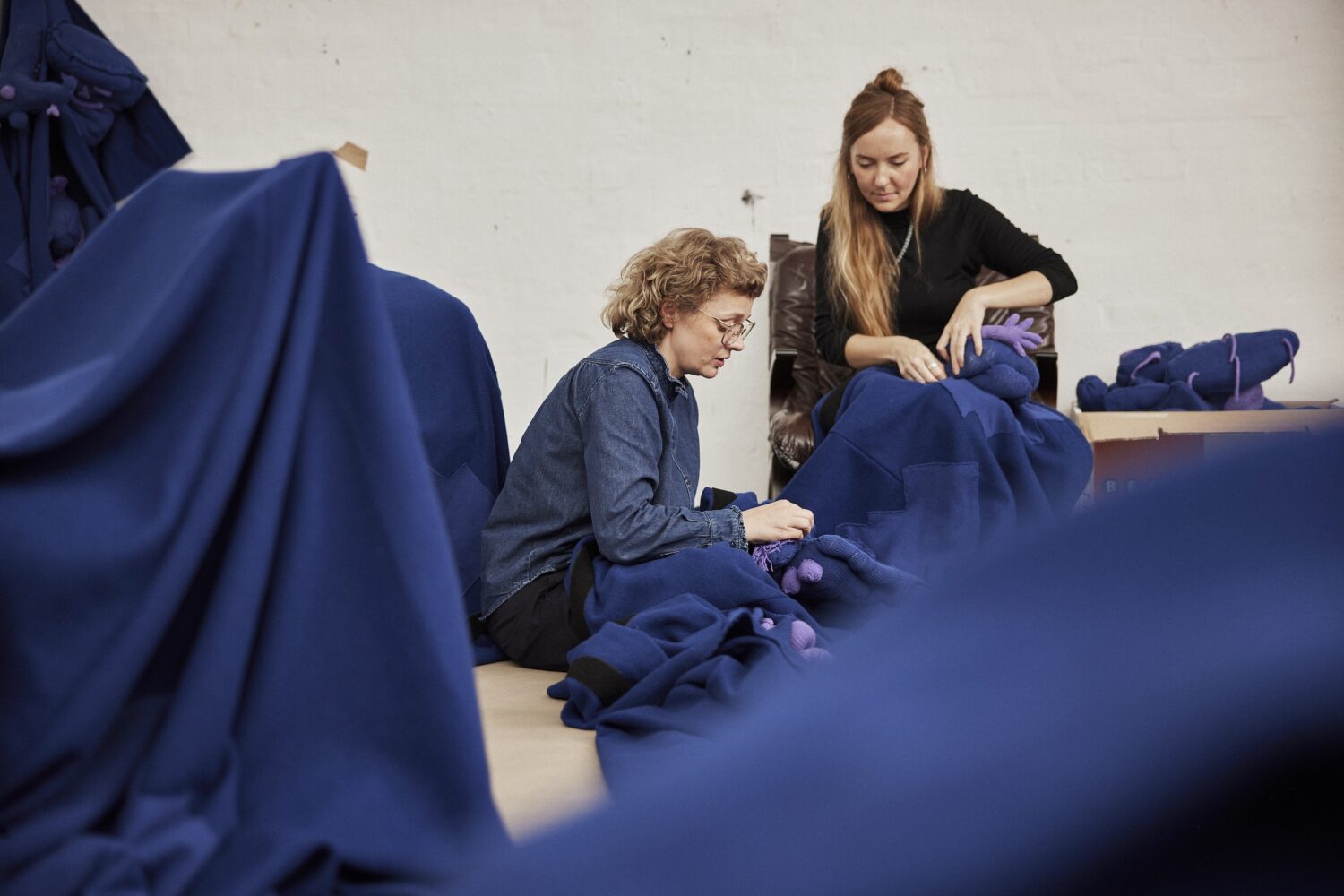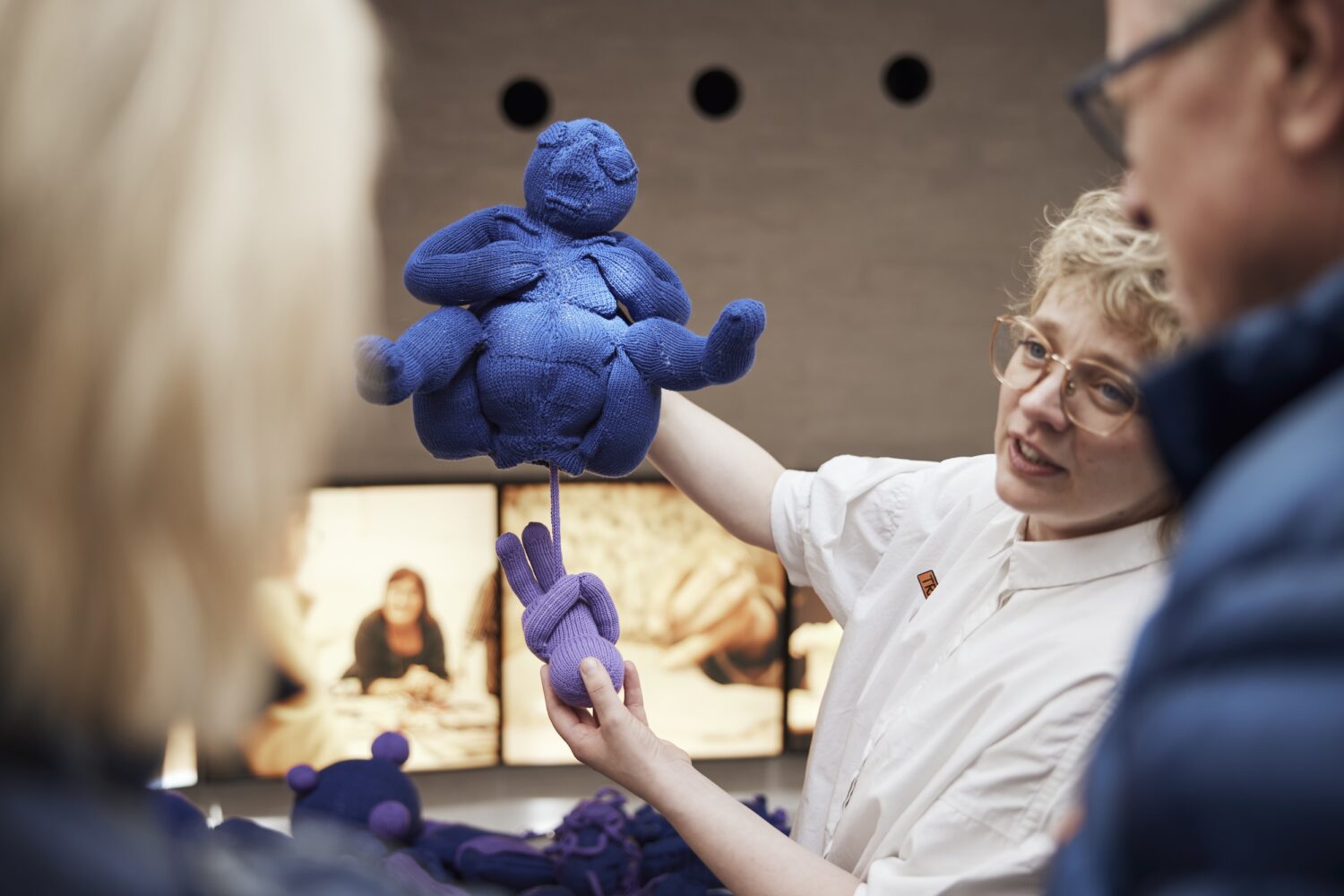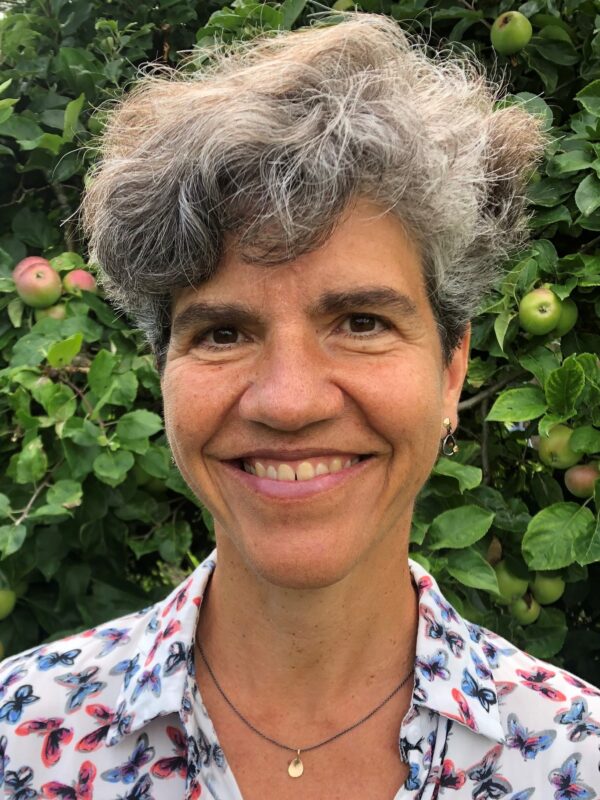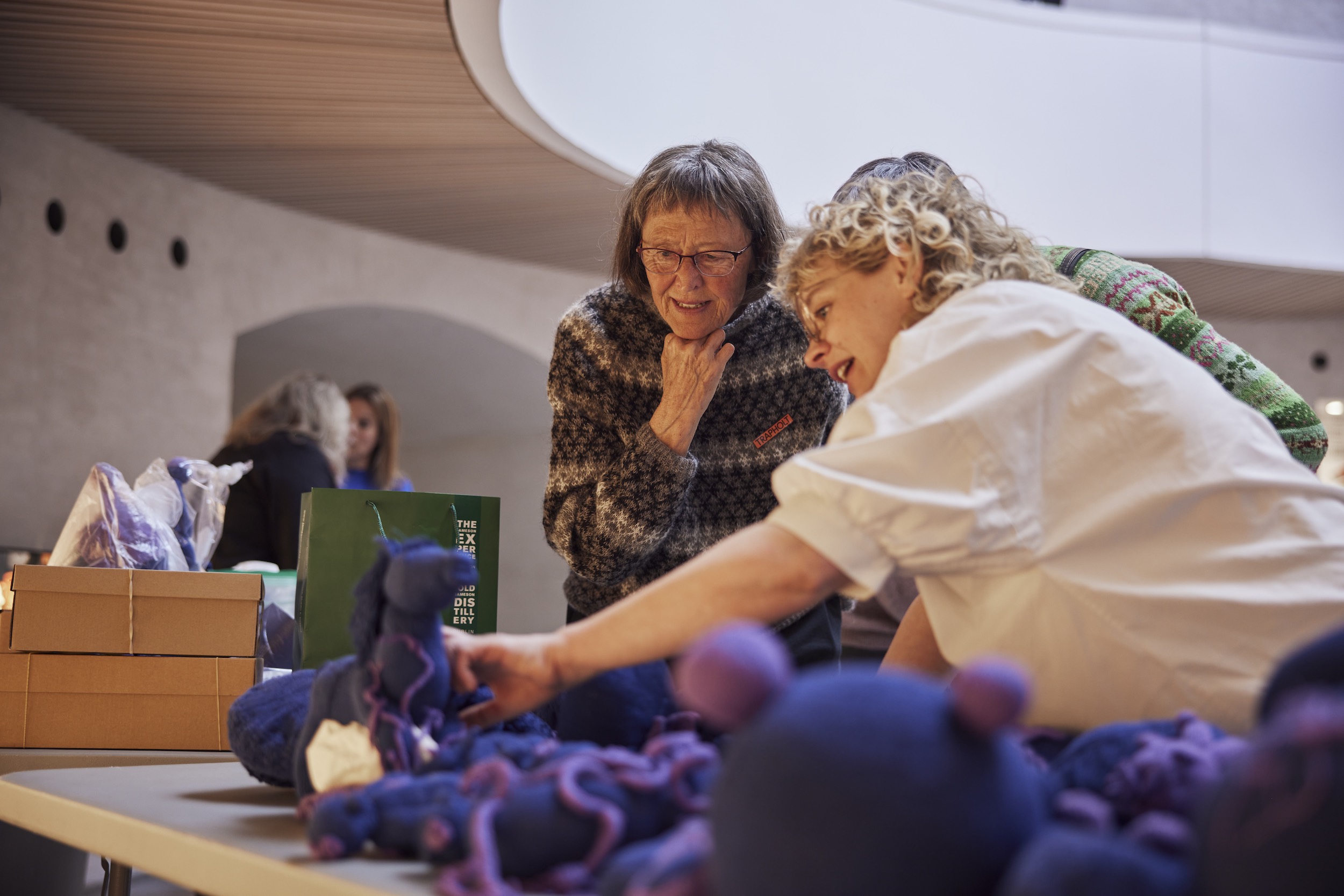Modifications in Small Knit
No fewer than 278 citizens have contributed to the co-creation project Things Matter, originating from and physically located at the art museum Trapholt in Kolding. The Faroese craftsperson and textile artist Randi Samsonsen, a graduate of the Design School in Kolding, is the creator of the artwork. In her role as the originator of the artwork, she has defined the piece, developed, and guided all the dogmas and processes that have ultimately resulted in the collaboratively created work.

In essence, the artwork consists of 278 knitted modifications of sculptures and artworks from the Faroe Islands and the entire Danish territory. Each of the 278 citizens with a flair for knitting was individually encouraged to select a sculpture or artwork in the public space near them that they wanted to reflect upon. Initially, each participant recreated the chosen piece in miniature, measuring 30 x 30 x 30 centimeters, using blue knitting yarn. Subsequently, the contributor added their own modification in the form of an addition, further development, or knitted ‘commentary’ to the work, executed in purple yarn. The result is 278 unique interpretations, which are currently exhibited together in the rotunda at Trapholt as a five-meter-tall installation.
Art Created Collaboratively
The entire art project is one of several that form part of the research conducted by Professor Birgit Eriksson at the Department of Communication and Culture. Her research focuses, among other things, on the impact of engaging citizens in participation projects in the art and museum world.
“For the past ten years, Trapholt has had a practice of community-based art projects. A couple of years ago, they decided to connect a research project to this practice to investigate the significance of citizen involvement – both for the contributors themselves, for what the contributions from citizens mean for the perception of the artwork that emerges, and for our general understanding of art,” she explains.
The project, named CraftVærk, began in 2021 and will conclude on January 1, 2024. In addition to theoretical work and literature studies, it includes interviews with participating citizens, questionnaire surveys, observations, and more.
The Process Turns Knitting into Art
“Things Matter contributes to challenging the boundaries of what art is,” says Birgit Eriksson. “Can 278 ordinary citizens, for example, create art? Yes, they can because there is an artist involved who initially designed the work, established the rules for how the work should be developed, and guided contributors through the process with instructions and workshops.”
“The artwork is not only the finished knitted objects; the entire process, involvement, and dogmas, which spectators can also gain insight into, contribute to making the project art. Another dimension is how the work is defined to a broader public: the fact that the work is exhibited in a museum, declaring it as art and preserving it for posterity, helps expand the boundaries of what art can be.”
A Push for the Gendered Art Scene
The project gives rise to expanding the conversation that currently permeates the entire cultural sphere, namely the discussion about gender in art. It is a well-known truth that the art world, both traditionally and today, is dominated by male artists and the masculine perspective.
This is evident, for example, in the fact that only five out of 101 named statues in public spaces in Copenhagen depict women. It is also reflected in who is represented in museums and galleries and favored in art purchases. So, what does it mean to base several co-creation projects at Trapholt on traditional women’s crafts such as knitting and embroidery – and thereby suddenly bring more women onto the art scene?

An Acknowledgment of Women’s Craftsmanship
“Art is a society’s self-reflection, where we see who we are and who we want to be. If there isn’t the diversity in art that we see in society, then women, underprivileged groups, minority ethnicities, and other groups will not be part of that reflection,” says Birgit Eriksson.
“With this project, women have a voice and are seen. It’s interesting to talk to the contributors, all of whom are women because it means a lot to them to be exhibited at Trapholt. They don’t perceive themselves as ‘artists,’ but their expressions are taken seriously and displayed in a place of status. It is a recognition of them and the skills they contribute. Many of them are incredibly talented. Some have worked professionally with knitting, for example, as crafts teachers, but there are also plenty of women who have simply knitted their whole lives and want to be challenged.”
Modifications with Care
Birgit Eriksson has also observed how the discipline of knitting—and perhaps the fact that women are behind the modifications—has contributed to giving the sculptures a new narrative.
“Most sculptures are made of hard materials like stone or iron, but now they take on a much softer expression. Many of the knitting women have actually articulated what they call care for the sculpture because they have gotten to know it and come to care for it.”
“A sculpture of a very thin and naked woman has been dressed and given a bit more fullness to the body,” she explains about a modification made by women from a center for people with alcohol problems, among other things.
Crafts as an Artistic Tool
It is evident from the name of Birgit Eriksson’s research project, CraftVærk, that she also investigates what it means for knitting, embroidery, or weaving as ‘craft’ to be the chosen form of expression in several co-creation projects.
“We can see on social media that there are many people practicing various crafts and are incredibly skilled at it. Some of these crafts have traditionally been looked down upon as artistic expressions because they have been considered women’s crafts – but here, they have found a place. Textile art, however, has gained a lot of ground in the last 20 years, including at Documenta in Kassel and the Biennale in Venice,” she explains.
The Craftsperson as an Artist
While craftsmanship, or ‘craft,’ is finding a place in art, Birgit Eriksson is not certain that craftsmanship will have a larger presence on the art scene.
“In several places, there is a perception that craftsmanship is too ‘nice’ and does not challenge enough. It is not necessarily the craftsmanship finish that makes a work of art, but the intention and ideas behind it. Conversely, many craftspeople might assess that the craftsmanship quality of much contemporary textile art simply does not meet their standards,” she believes.
On the other hand, craftspeople can contribute to involving many more people in conversations about art. An example is Randi Samsonsen and what she has done with her work:
“Things Matter is not Samsonsen’s individual work, but through her conceptualization and design of the processes and the intention behind the project, she and Trapholt have engaged hundreds of citizens in a conversation about and exploration of art.”
Regarding the preliminary insights from the research project, she says:
“We need to open our eyes to the fact that many people have interesting skills with ‘craft’ that are relevant to art, and it can happen through various forms of expression – including those that have been looked down upon as feminine, such as knitting, weaving, and embroidery.”
Facts
CraftVærk is a collaboration between Trapholt Museum (Director Karen Grøn and Project Manager Nina Schrøder) and Aarhus University (Prof. Birgit Eriksson and Postdoc Tina Louise Hove Sørensen). The project is supported by the Velux Foundation. Read more
Learn more about the exhibition at Trapholt
Photo of Birgit Eriksson.

Theme: Crafts and Design in Public Spaces
Formkraft has focused on crafts and design in public and semi-public spaces in its publications: Atmosfære, Trivsel, and Byens Rum.
More Knowledge in the Archive
Dive into Formkraft’s archive, which contains digitized journals from 1948 to now.
Read the article “Fællesskabte kunstværker på Trapholt” (Collaborative Artworks at Trapholt)


